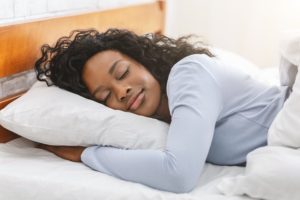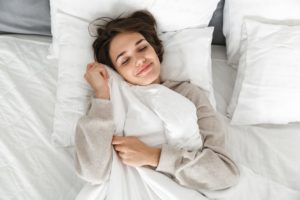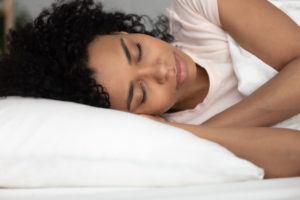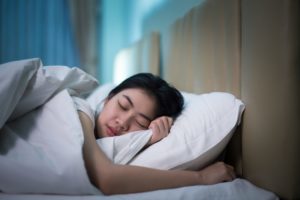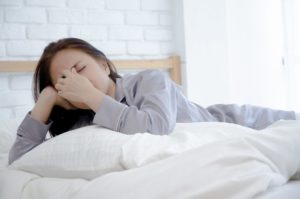Slow-Wave Sleep
Slow-wave sleep, also called deep sleep, is a stage of sleep that seems to play an important role in growth, memory, and immune function. Slow-wave sleep is vital for waking up feeling revitalized.
Learn more about slow-wave sleep, including what happens in the body during this period of rest, the potential impacts of slow-wave sleep on health, and the types of sleep problems and medical conditions that are related to slow-wave sleep.
What Is Slow-Wave Sleep?
Slow-wave sleep is the third stage of sleep. During a night of sleep, children and adults progress through four sleep stages: three stages of non-rapid eye movement (NREM) sleep and one stage of rapid eye movement (REM) sleep. Each stage is associated with certain changes in activity in the brain and body. A person typically cycles through these sleep stages four to six times each night.
During slow-wave sleep, electrical activity in the brain changes while the body relaxes into deep and restorative rest. Each period of slow-wave sleep lasts from 20 to 40 minutes, and the majority of slow-wave sleep happens early in the night.
Most adults spend around 10% to 20% of their sleep in slow-wave sleep. As a person gets older, they typically spend less time in slow-wave sleep.
Recent sleep patterns can affect slow-wave sleep. After a period of sleep loss, a person usually gets a higher proportion of slow-wave sleep as the brain and body seek to make up for prior sleep deprivation. On the other hand, some people with long-lasting insomnia have a tendency to spend less time in slow-wave sleep.
What Happens to the Body and Brain During Slow-Wave Sleep?
Slow-wave sleep was given its name based on the characteristic brain waves that can be observed during this stage of sleep. Brain waves are a visual representation of the brain’s electrical activity as measured by special equipment. These waves can be used to assess what is happening in the brain at different times. During this third stage of sleep, brain waves slow and begin a notable pattern that indicates a person is in deep sleep.
Along with brain waves, a sleeper’s heart rate and blood pressure slow down during this stage of sleep. Researchers believe that this nightly dip in blood pressure is important for cardiovascular health . Sleepers who do not have this decrease in blood pressure while sleeping may be at an increased risk of complications from high blood pressure, including stroke and heart failure.
During slow-wave sleep, breathing becomes slow and steady. Muscles become progressively more relaxed. When a person is in slow-wave sleep, it is typically more difficult to awaken them.
Slow-wave sleep is also a time when important hormones are produced. For example, slow-wave sleep involves increased secretion of growth hormone , which affects metabolism and the health of bones and muscles.
What Is the Function of Slow-Wave Sleep?
Although researchers are still working to fully understand the purpose of each stage of sleep, experts believe that slow-wave sleep has a wide range of vital functions in the body.
Slow-wave sleep appears to play a key role in making sleep refreshing and reducing the pressure to sleep during the day. Sleep pressure grows the longer a person remains awake, which is a signal that they need to rest. Slow-wave sleep helps relieve this pressure so that sleep is more restorative.
Other functions of slow-wave sleep include supporting memory, boosting immune function, facilitating the growth and repair of tissues, and enabling the elimination of waste products from the body.
- Learning and memory: Research suggests that the brain activates newly acquired memories during slow-wave sleep in order to help them become part of a person’s long-term memory. At the same time, slow-wave sleep may facilitate learning by helping to restore connections between brain cells that can become overwhelmed during waking hours.
- Tissue growth and repair: Hormonal shifts during slow-wave sleep help the body heal and grow muscle and bone . In fact, the release of growth hormone reaches its pinnacle during slow-wave sleep.
- Immunity: Changes in the release of hormones during slow-wave sleep also benefit the immune system . Studies suggest that slow-wave sleep is an important time for the development of adaptive immunity, a process in which the body builds up its ability to detect and fight disease-causing pathogens.
- Expelling waste: Slow-wave sleep may be important for the elimination of waste products from the fluid surrounding the brain and spinal cord. Specifically, slow-wave sleep could be a time for the body to clear amyloid-beta proteins, which are associated with the development of dementia .

Sleep Issues Associated With Slow-Wave Sleep
While slow-wave sleep is a normal and important part of a typical sleep cycle, there are sleep problems associated with this stage, especially when someone is awakened from slow-wave sleep.
The deepest sleep happens during slow-wave sleep, which makes it difficult to wake up a sleeper during this stage. Even sounds as loud as 100 decibels, which is around the volume of a car horn, may not wake a person from slow-wave sleep.
If a person does wake up during slow-wave sleep, they are likely to experience sleep inertia. Sleep inertia is a period of fogginess and disorientation after waking up that can negatively affect thinking and mood. Sleep inertia can be disruptive but typically resolves within 60 minutes .
Slow-wave sleep is also associated with several sleep disorders called NREM-related parasomnias. Also called disorders of arousal, these parasomnias involve behaviors that occur when a person partially awakens from NREM sleep but is also still partially asleep. Because they occur most often during slow-wave sleep, NREM parasomnias are most likely to happen early in the night.
- Confusional arousals: Confusional arousals are a type of parasomnia that occurs when a person experiences an excessive amount of sleep inertia. Up to 17% of children and 4% of adults experience confusional arousals. Most confusional arousals are characterized by a brief period of fogginess, slowed speech, and lack of memory. Less often, other behaviors may arise during a confusional arousal, such as sexsomnia.
- Sleepwalking: Sleepwalking can occur when a person only partly wakes up from slow-wave sleep. A person who sleepwalks may get out of bed, have their eyes open, and appear to be completing a task. They may even run, make sounds, or eat, but they are generally not aware of this activity. Sleepwalking most commonly affects people between the ages of 8 to 12 years old but can occur in any age group.
- Sleep terrors: Sleep terrors involve waking up unexpectedly with a powerful sense of fear and confusion. A person may sit up in bed, yell, and exhibit symptoms like sweating, a fast heartbeat, and rapid breathing. They usually do not remember the experience the following day. Sleep terrors affect up to 40% of young children, and they also occur in around 3% of adults.
- Sleep talking: Sleep talking is a common parasomnia that can also occur during NREM sleep, especially slow-wave sleep. Nearly 70% of people sleep talk at some point in their lives.
Medical Issues Associated With Slow-Wave Sleep
Various aspects of a person’s health can influence their slow-wave sleep. Fever, exercise, and several medications can cause a temporary increase in slow-wave sleep. Medications that increase slow-wave sleep include some antipsychotics, antidepressants, and anti-seizure medications.
A number of health conditions can lead to a decrease in slow-wave sleep. Examples of these issues include:
- Stress
- Depression
- Arthritis
- Back pain
- Cardiovascular disease
- Dementia, including Alzheimer’s disease
- Conditions that interfere with breathing, like asthma and obstructive sleep apnea
Substances that decrease slow-wave sleep include alcohol, opioids, and drugs that stimulate the central nervous system.
While these health issues may disrupt slow-wave sleep, there is evidence that a lack of deep sleep may affect overall health. Inadequate slow-wave sleep is associated with memory impairment and an increased risk of type 2 diabetes and high blood pressure .
Slow-Wave Sleep in Children vs. Adults
Sleep in newborns and infants differs significantly from sleep in adults. Compared to an adult, a baby needs more total sleep, transitions directly from being awake into REM sleep, and spends less time in NREM sleep stages. Distinct sleep stages develop as a baby gets older, with slow-wave sleep beginning around 4 to 6 months old .
Children get the most slow-wave sleep, which may explain why it can be more difficult to wake children up from sleep.
The amount of slow-wave sleep a person gets decreases after puberty and into adulthood. Adolescents and adults usually spend from 10% to 20% of their sleep time in slow-wave sleep.
For older adults, nightly slow-wave sleep continues to decrease. This reduction in slow-wave sleep may help to explain age-related worsening of memory and the increased tendency among older adults to feel tired after waking up in the morning.
Understanding Your Sleep Cycle
It is becoming increasingly common to want to optimize sleep by learning how well your body transitions through different sleep stages. In many cases, this means trying out a sleep tracker, which is a wearable device, smartphone application, or portable monitor that gathers information about your sleep.
Although many devices and applications are available, it is important to interpret the information provided by sleep trackers with caution . Few of these devices have been proven to be effective and accurate in research studies, so they may not correctly or consistently identify your sleep stages.
Despite the potential limitations of sleep trackers, your results may be helpful in knowing when it is time to bring up sleeping problems with a doctor who can recommend more formal testing if it is necessary.
If you are concerned about your sleep patterns and whether you are getting sufficient slow-wave sleep, it is best to consult with a doctor or sleep specialist. Doctors have a variety of tools at their disposal to monitor sleep, diagnose the cause of sleep issues, and treat the potential causes of sleep loss.

Still have questions? Ask our community!
Join our Sleep Care Community — a trusted hub of sleep health professionals, product specialists, and people just like you. Whether you need expert sleep advice for your insomnia or you’re searching for the perfect mattress, we’ve got you covered. Get personalized guidance from the experts who know sleep best.
References
15 Sources
-
Cirelli, C. (2022, October 10). Insufficient sleep: Definition, epidemiology, and adverse outcomes. In R. Benca (Ed.). UpToDate., Retrieved January 15, 2023, from
https://www.uptodate.com/contents/insufficient-sleep-definition-epidemiology-and-adverse-outcomes -
National Center for Chronic Disease Prevention and Health Promotion, Division for Heart Disease and Stroke Prevention. (2021, January 4). How does sleep affect your heart health? Centers for Disease Control and Prevention., Retrieved January 15, 2023, from
https://www.cdc.gov/heart-disease/about/sleep-and-heart-health.html -
Dijk D. J. (2009). Regulation and functional correlates of slow wave sleep. Journal of Clinical Sleep Medicine, 5(2 Suppl), S6–S15.
https://pubmed.ncbi.nlm.nih.gov/19998869/ -
Stepan, M. E., Altmann, E. M., & Fenn, K. M. (2021). Slow-wave sleep during a brief nap is related to reduced cognitive deficits during sleep deprivation. Sleep, 44(11), zsab152.
https://pubmed.ncbi.nlm.nih.gov/34156468/ -
Zhang, Y., & Gruber, R. (2019). Can slow-wave sleep enhancement improve memory? A review of current approaches and cognitive outcomes. The Yale Journal of Biology and Medicine, 92(1), 63–80.
https://pubmed.ncbi.nlm.nih.gov/30923474/ -
Patel, A. K., Reddy, V., Shumway, K. R., & Araujo, J. F. (2022, September 7). Physiology, sleep stages. In StatPearls. StatPearls Publishing., Retrieved January 15, 2023, from
https://www.ncbi.nlm.nih.gov/books/NBK526132/ -
Léger, D., Debellemaniere, E., Rabat, A., Bayon, V., Benchenane, K., & Chennaoui, M. (2018). Slow-wave sleep: From the cell to the clinic. Sleep Medicine Reviews, 41, 113–132.
https://pubmed.ncbi.nlm.nih.gov/29490885/ -
National Institute on Aging. (2017, May 16). What happens to the brain in Alzheimer’s disease?, Retrieved January 15, 2023, from
https://www.nia.nih.gov/health/what-happens-brain-alzheimers-disease -
Hilditch, C. J., Dorrian, J., & Banks, S. (2016). Time to wake up: Reactive countermeasures to sleep inertia. Industrial Health, 54(6), 528–541.
https://pubmed.ncbi.nlm.nih.gov/27193071/ -
Morse, A. M., Kotaga, S. (2021, October 20). Parasomnias of childhood, including sleepwalking. In R. D. Chervin (Ed.). UpToDate., Retrieved January 15, 2023, from
https://www.uptodate.com/contents/parasomnias-of-childhood-including-sleepwalking -
Roehrs, T., Roth, T. (2022, April 13). The effects of medications on sleep quality and sleep architecture. In R. Benca (Ed.). UpToDate., Retrieved January 15, 2023, from
https://www.uptodate.com/contents/the-effects-of-medications-on-sleep-quality-and-sleep-architecture -
Mander, B. A., Winer, J. R., & Walker, M. P. (2017). Sleep and Human Aging. Neuron, 94(1), 19–36.
https://pubmed.ncbi.nlm.nih.gov/28384471/ -
Javaheri, S., Zhao, Y. Y., Punjabi, N. M., Quan, S. F., Gottlieb, D. J., & Redline, S. (2018). Slow-wave sleep is associated with incident hypertension: The sleep heart health study. Sleep, 41(1), zsx179.
https://pubmed.ncbi.nlm.nih.gov/29087522/ -
Grigg-Damberger, M. (2022, April 15). Overview of polysomnography in infants and children. In R. D. Chervin (Ed.). UpToDate., Retrieved January 15, 2023, from
https://www.uptodate.com/contents/overview-of-polysomnography-in-infants-and-children -
Thomas, S. J. & Gable, K. (2022, May 23). Actigraphy in the evaluation of sleep disorders. In S. M. Harding (Ed.). UpToDate., Retrieved January 15, 2023, from
https://www.uptodate.com/contents/actigraphy-in-the-evaluation-of-sleep-disorders


